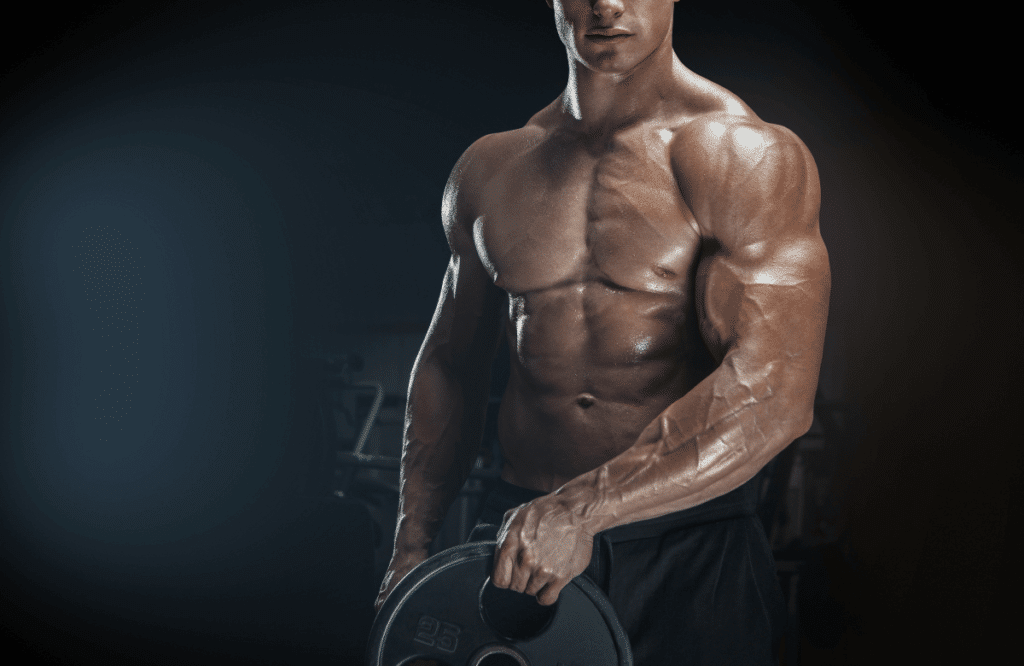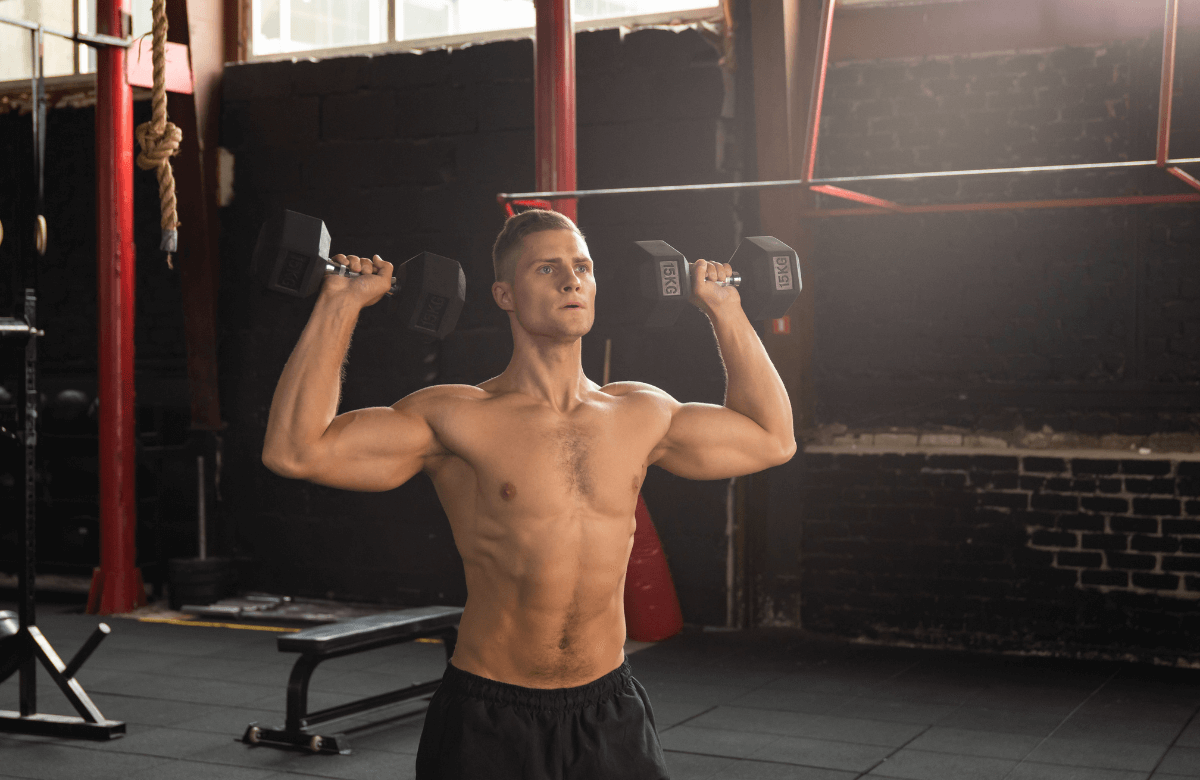Your lateral deltoid muscles can be easily forgotten, but if your goal is massive shoulders that are devoid of shoulder pain then you’re going to want to read this article. Many people design their shoulder routine with a general idea of their upper body muscle mass, but by knowing and specifically targeting certain shoulder muscles you can properly form well-developed shoulders much faster. So for this article, we’re going to target the lateral deltoid, though we’ll start off with a brief overview of deltoids so you know what we’re talking about.
Jump to:
What Are Deltoids?
Your deltoids are in your shoulders and are the ball and socket muscle that connects your arm to the trunk of your body and looks like an upside-down triangle.
Your deltoid muscles cover the top of the shoulder and are superficial, which means they’re close to the surface of your skin. The base of the deltoids connects to the upper part of your scapula (shoulder blade) and the side of your clavicle and the very top point of the deltoids attaches to the side of your humerus (the arm bone between your shoulder and elbow).

How Are The Deltoid Muscles Structured?
The deltoid muscles have three parts as mentioned above and they’re in the shape of a triangle. The front delts or anterior deltoids help move your arm forward and connect your clavicle. This is the muscle to help you reach for an object on a shelf. Then the side delts or lateral delts help you move your arm from side to side as well as up and down and connect to the acromion (a bony knob on your shoulder blade). Then there are the posterior deltoids or rear delts which help move your arm backward and connect to the flat surface of your shoulder blade.
How Do You Target Side Deltoids?
So this brings us to the real question, how do you target your side delts and reach your fitness goals of getting those boulder shoulders? To answer this question we’ve concocted a list of the top eight lateral deltoid exercises to strengthen your side delts.

The Best Side Delt Exercises
So here are the best delt workouts you need to add to your regime to progress your fitness journey:
Lying Dumbbell Lateral Raise
Start this exercise and your journey to upper body gains by lying on your right forearm with your abdomen extended straight and your core engaged. Hold a light weight in your left hand straight out and parallel to your body. Slowly raise your left arm up and down making sure to exhale when you lift up and inhale when you lower it. Repeat the up and down motion once and then call it a rep, not stopping until you finish your entire set.
One-arm Cable Lateral Raise
Another great shoulder exercise is one done on the cable machine. With your feet shoulder-width apart, stand sideways to the cable machine and grab the handle close to your waist and the other on your hip for balance. With your pelvis tucked in and a firm grip on the cable handle, use your range of motion and lift your arm until your arm is parallel with the ground (meaning stop once you reach shoulder level) while exhaling. Make sure to keep your elbow bent and avoid using a heavier weight. Once you’re at the top position of the workout, lower and inhale, controlling the weight the whole way down. Keep repeating until your set is finished.
Barbell Upright Row
The barbell upright row is a fantastic upper body exercise that hits all the main deltoid muscles including the rear delts. For this, your starting position is going to be your feet shoulder-width apart and your hands on the barbell so they’re shoulder-width apart as well. Once you’re ready, contract your core and your shoulder blades and with an overhand grip pull the bar up to your chin. As you raise the barbells, make sure your elbows are always higher than your wrists and the barbell as close to your body as possible. If you are experiencing pain in your wrists while performing the exercise you can use a EZ curl bar instead.
Seated Barbell Shoulder Press
Begin this exercise by sitting on a bench with your feet on the ground and your shoulders and back against the pad. Grab the barbell just outside shoulder width apart and hold it as tight as you can above your head. While keeping your core engaged and your lower back against the pad, lower the bar to your chest, making sure to keep your wrists straight with your elbows angled slightly forward. Push up until your arms are straight and then lower back down only stopping once the barbell makes contact with your chest. Repeat the steps over again until done.
Lu Raise
A good exercise for shoulder mobility and overall shoulder mechanics is the lu raise. Start this exercise by flexing the core muscles and glutes. With firm grips on weighted plates in both hands, lift them with your arms straight to the side as if you were to do jumping jacks without the jumping part. Make sure to allow your shoulders to shrug and keep your wrists from turning. Continue the up-and-down motion to work those shoulder muscles until your set is done.
Cable Lateral Raise
Start the lateral raise exercise with a lighter weight, stand beside a cable machine, grab the cable grip, and hold it at your waist. Lean slightly forward with your feet shoulder-width apart. You can grab the cable with more of an open-hand grip or the actual cable itself for an easier handle. Use your other hand to grab the cable machine to assist in keeping you stationary and that’s going to be your starting position. Start your shoulder workout by gently rotating your arm so that your palm is parallel with the floor while raising it to shoulder height and lowering it back down to the starting position. Make sure to control the way down and lower the weight slowly. If it’s too fast or you do it carelessly you could risk injury to your lateral delts as well hinder your shoulder growth. This is a fantastic cable exercise to do for 6-12 reps and then rest.
Reverse Pec Deck Fly
Adjust your pec deck machine seat so it aligns your arms with the pec deck handles. Your arms shouldn’t be angled down or up and not too far back or too close that your arms are super bent. Get the best shoulder development results by angling your hands about 30-45 degrees on the handle so they’re not completely flat and they’re not gripping the side of the pec deck arms. Start out with moderate weight and press outwards and get that delt activation. Control it on the way back to your starting position and then while keeping your core tight. This is an amazing exercise for muscle growth to help build the well-developed side delts. You can also use resistance bands to do a similar exercise but are more of a secondary option if you’re limited on gym equipment.
Seated Cable Row
Another effective workout is the seated row to assist with strong side delts. Start the exercise by sitting on the row machine and placing your feet on the platform or crossbar. Make sure your knees are bent and lean over to grab the cable handles while keeping your back neutral. With your arms extended, pull back on the handles until your torso is at a 90-degree angle to your legs. Your back should be lightly arched as you bring your arms as close as you can to your body while you squeeze your shoulder blades together. Extend your arms back to their starting position and then bring them back to your chest, repeating this action until you’re done with your set.
Arnold Dumbbell Press
For this lateral delt exercise, sit on an upright bench with two lighter dumbbells in front of you on the ground. Pick them up with your palms facing you and your elbows bent. The starting position should look very similar to the contracted position of a dumbbell curl. As you perform the movement, exhale and raise the dumbbells like you would for overhead presses, though instead of just straight up and down you’re going to do this rotation motion by rotating the palms of your hands outward. Keep lifting your arms until they’re fully extended and then lower them back to the starting position and then call that a rep.















